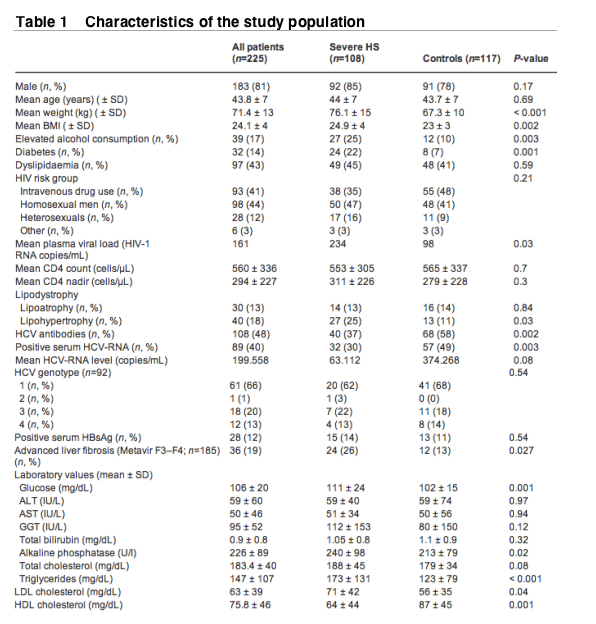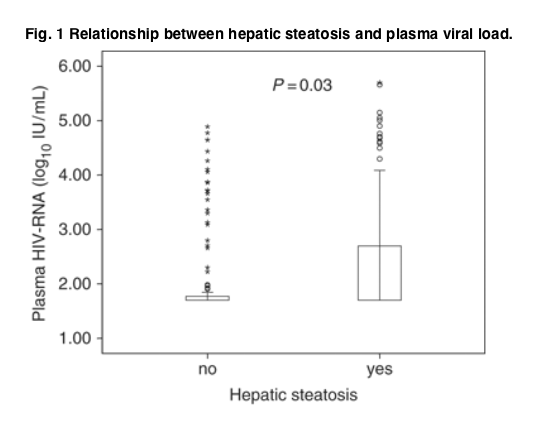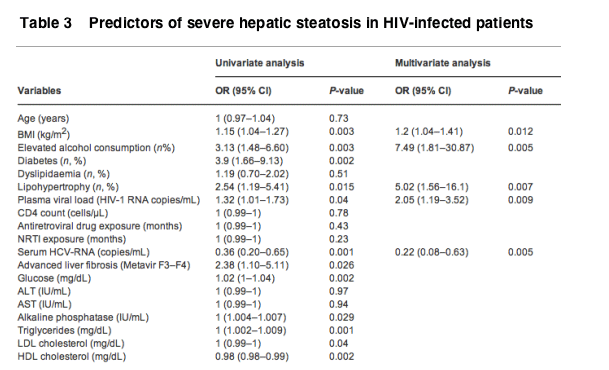| |
Predictors of severe hepatic steatosis using abdominal ultrasound in HIV-infected patients
|
| |
| |
HIV Medicine Jan 2009
P Ryan 1 , F Blanco 1 , P Garcia-Gasco 1 , JA Garcia-Merchan 1 , E Vispo 1 , P Barreiro 1 , P Labarga 1 , J Gonzalez-Lahoz 1 and V Soriano; 1 Department of Infectious Diseases, Hospital Carlos III, Madrid, Spain
"Mean values of BMI, glucose, low-density lipoprotein (LDL) cholesterol and triglycerides, as well as the prevalence of elevated alcohol consumption, diabetes mellitus and lipohypertrophy, were significantly increased in patients with HS compared with controls. Interestingly, plasma viral load levels were significantly higher in patients with HS (hepatic steatosis [fatty liver]) than in control...
....The results of the logistic regression analysis are displayed in Table 3. In the univariate analysis, increased values for BMI, glucose, LDL cholesterol, high-density lipoprotein (HDL) cholesterol and triglycerides, as well as higher rates of alcohol abuse, diabetes and lipohypertrophy, were associated significantly with severe HS. In addition, elevated plasma viral load levels were also associated significantly with HS. In contrast, serum HCV-RNA levels correlated inversely with HS. In the multivariate analysis, only a higher BMI, elevated alcohol consumption, lipohypertrophy, lower serum HCV-RNA and (conversely) higher plasma viral load levels remained as independently associated to severe HS....
....Severe HS was diagnosed in 108 (13%) of patients who underwent US. In four of them, a liver biopsy could be obtained and features of HS were confirmed in all cases (although with a wide range of fat deposition). Two patients showed more than 50% of hepatocytes with fat deposition, while this level was around one third for the other two individuals. The former two patients showed significant degrees of liver fibrosis (Metavir scores F2 and F3, respectively). There was no fibrosis in the latter two. None showed signs of damage caused by elevated alcohol consumption.....Their mean age was 43 years and 81% were men. Their mean CD4 count was 560 cells/μL and 69% had undetectable plasma viral load. Overall, 40% had chronic HCV and 12% chronic hepatitis B. Elevated alcohol consumption was admitted by 17% of individuals. Diabetes and hyperlipidaemia were present in 14 and 43% of patients, respectively. In 185 patients (82.2%), liver fibrosis could be measured in parallel with US using transient elastography. Advanced liver fibrosis (Metavir scores F3 and F4) was present in 19% of patients, and was recognized significantly more frequently in patients with HS than in controls (26 vs. 13%; P=0.015)."
ABSTRACT
Objective: Multiple factors may lead to hepatic steatosis (HS) in HIV-positive patients. HS may result in severe liver damage on its own and/or by accelerating the progression of chronic viral hepatitis B or C.
Methods: The sensitivity/specificity of liver ultrasound (US) to recognize severe HS is above 85%. A cross-sectional case-control study of all HIV out-patients who underwent liver US since 2004 was conducted at our institution.
Results: Eight hundred and thirty (36.1%) out of 2300 HIV-positive patients on regular follow-up underwent liver US during the study period. Severe HS was diagnosed in 108 (13%) patients. A total of 117 matched HIV controls lacking HS were selected randomly. In patients with severe HS, we found significantly higher values of body mass index (BMI), plasma viral load, serum glucose, alkaline phosphatase, triglycerides and low-density lipoprotein cholesterol, as well as significantly higher prevalence of diabetes, elevated alcohol consumption, lipohypertrophy and advanced liver fibrosis. Furthermore, a trend towards longer exposure to nucleoside analogues was noticed. In the multivariate analysis, only elevated alcohol consumption [odds ratio (OR) 7, P=0.013], lipohypertrophy (OR 5.3, P=0.008), plasma viral load (OR 2.1, P=0.02), BMI (OR 1.2, P=0.013) and serum glucose (OR 1.03, P=0.027) were significantly associated with severe HS.
Conclusions: Severe HS in HIV-positive patients is associated with predisposing factors that are similar to those of HIV-negative individuals. However, its characteristic association with elevated plasma viral load might suggest a direct involvement of HIV in liver fat deposition. Therefore, the benefit of controlling HIV replication with antiretroviral therapy should be balanced against its effect of occasionally inducing metabolic abnormalities and lipodystrophy.
Introduction
Hepatic steatosis (HS) is a manifestation of excessive accumulation of triglycerides in the liver. When it is accompanied by inflammation and fibrosis, there is an increased risk of progression to severe liver disease [1]. HS often accounts for unexplained liver enzyme elevations in persons with no predisposing liver conditions [2]. The prevalence of HS depends on the study population and the method used to make the diagnosis. In the general population, the prevalence of HS is 16-29% using ultrasonography (US) [3-5], 31-34% using proton magnetic resonance [6,7] and 15-39% using liver biopsy [8-10]. HS can be found in up to half of patients with chronic hepatitis C virus (HCV) infection, and is particularly prevalent in the sub-set of individuals infected with HCV genotype 3 [11,12]. In patients with HIV infection, the prevalence of HS ranges between 3 and 57% [13,14]; HS seems to be more common (40-69%) [15-18] and more severe [19] in HIV-HCV co-infected patients.
Classical risk factors for HS are linked to the host, such as alcohol abuse and metabolic abnormalities associated with insulin resistance (obesity, diabetes, dyslipidaemia) [20]. In patients co-infected with HIV and HCV, HS has been associated with higher serum HCV load and/or HCV genotype 3 as well as the use of some antiretroviral (ARV) agents [17,21,22] such as nucleoside reverse transcriptase inhibitors (NRTIs) (through mitochondrial toxicity) and protease inhibitors (which may induce insulin resistance).
Liver biopsy remains the best diagnostic tool for recognizing and measuring the extent of HS [23]. However, this invasive procedure entails some risks for the patient and is not suitable as a routine diagnostic tool for HS [24]. Furthermore, sampling error of liver biopsy can result in substantial misdiagnosis and staging inaccuracies [25,26], especially when the tissue size is relatively small [27]. Consequently, efforts have been made to identify non-invasive methods to recognize HS [28,29]. US is generally requested as the first imaging technique to assess liver parenchyma and the extent of damage in patients with potential liver illnesses. The correlation between HS suggested by US and its proof on liver biopsy remains controversial [30-32]; however, the correlation is excellent when only severe HS is assessed [33,34]. Severe HS is diagnosed using US based on four findings: bright hepatic parenchyma, enhanced liver-kidney contrast, vascular blurring and deep hepatic attenuation. The sensitivity, specificity, positive predictive value and negative predictive value of a bright hepatic ultrasound for HS are 64, 97, 96 and 65%, respectively. However, these values increase to 91, 93, 89 and 94%, respectively, for severe HS (30% or more hepatocytes with fat accumulation on liver biopsy) [34-36]. Compared with magnetic resonance, which is the most sensitive non-invasive tool for HS, the performance of US is equally useful in the diagnosis of severe HS [37]. In this study, we assessed the prevalence and predictors of severe HS in a relatively large group of HIV-infected patients who underwent hepatic US.
Results
Eight hundred and thirty (36.1%) out of 2300 HIV-positive patients on regular follow-up underwent hepatic US during the study period. Severe HS was diagnosed in 108 (13%) of patients who underwent US. In four of them, a liver biopsy could be obtained and features of HS were confirmed in all cases (although with a wide range of fat deposition). Two patients showed more than 50% of hepatocytes with fat deposition, while this level was around one third for the other two individuals. The former two patients showed significant degrees of liver fibrosis (Metavir scores F2 and F3, respectively). There was no fibrosis in the latter two. None showed signs of damage caused by elevated alcohol consumption. One hundred and seventeen patients without evidence of HS using US were selected as controls, after matching for gender and age. The main characteristics of these 225 individuals, as well as differences between groups, are depicted in Table 1. Their mean age was 43 years and 81% were men. Their mean CD4 count was 560 cells/μL and 69% had undetectable plasma viral load. Overall, 40% had chronic HCV and 12% chronic hepatitis B. Elevated alcohol consumption was admitted by 17% of individuals. Diabetes and hyperlipidaemia were present in 14 and 43% of patients, respectively. In 185 patients (82.2%), liver fibrosis could be measured in parallel with US using transient elastography. Advanced liver fibrosis (Metavir scores F3 and F4) was present in 19% of patients, and was recognized significantly more frequently in patients with HS than in controls (26 vs. 13%; P=0.015).

Mean values of BMI, glucose, low-density lipoprotein (LDL) cholesterol and triglycerides, as well as the prevalence of elevated alcohol consumption, diabetes mellitus and lipohypertrophy, were significantly increased in patients with HS compared with controls. Interestingly, plasma viral load levels were significantly higher in patients with HS than in controls (Fig. 1). In contrast, HCV antibodies and detectable HCV viraemia were less frequent in patients with severe HS than in controls.

Prior exposure to antiretroviral therapy (ART) did not differ significantly in patients with HS and controls, as shown in Table 2. This observation was confirmed even when considering separately the length of exposure to different drug classes or to any single drug. Nevertheless, a trend towards an association between severe HS and longer exposure to ARV treatment - specifically with NRTIs - was observed.
The results of the logistic regression analysis are displayed in Table 3. In the univariate analysis, increased values for BMI, glucose, LDL cholesterol, high-density lipoprotein (HDL) cholesterol and triglycerides, as well as higher rates of alcohol abuse, diabetes and lipohypertrophy, were associated significantly with severe HS. In addition, elevated plasma viral load levels were also associated significantly with HS. In contrast, serum HCV-RNA levels correlated inversely with HS. In the multivariate analysis, only a higher BMI, elevated alcohol consumption, lipohypertrophy, lower serum HCV-RNA and (conversely) higher plasma viral load levels remained as independently associated to severe HS.

Patients and methods
Study population
A case-control study was performed retrospectively in HIV-positive patients on regular follow-up at the out-patient clinic of Hospital Carlos III, a reference centre for HIV/AIDS located in Madrid, Spain. All patients who underwent liver US between January 2004 and May 2007 were identified. Only US requested to provide complementary information in HIV-positive patients with persistently elevated liver enzymes and/or with chronic hepatitis of any aetiology (viruses, alcohol) was selected. US requested for acute liver events was excluded from this analysis. Three experienced radiologists carried out all the liver US examinations. Severe HS was diagnosed by the radiologists based on the consideration of characteristic imaging findings, namely bright liver pattern, liver-kidney contrast, vascular blurring and/or deep hepatic attenuation. The diagnosis was established when two or more of these findings were recognized by the radiologist. Age- and gender-matched HIV-positive individuals who underwent US and did not show any evidence of HS were selected as controls.
Liver fibrosis was measured in all cases and controls using transient elastography (Fibroscan; Echosens, Paris, France). Using this non-invasive tool to assess hepatic fibrosis, values above 13.0 kPa correlate well with Metavir scores of F3 or more. For values above 14.5 kPa, the correlation with F4 (cirrhosis) in the liver biopsy is >95% [38]. Demographics, metabolic risk factors, alcohol consumption and use of highly active antiretroviral therapy (HAART) (months accumulated under each drug) were recorded in a case report form especially designed for this study. Elevated alcohol consumption was defined as daily intake >60 g. Lipodystrophy was defined as sub-cutaneous fat loss (lipoatrophy) and/or increased girth or buffalo hump (lipohypertrophy), reported by the patient and confirmed by the doctor in charge.
Laboratory parameters
Tests included complete blood cell counts, aspartate transaminase, alanine transaminase, bilirubin, alkaline phosphatase, Y-glutamyl transferase and a complete lipid profile. Immunological parameters such as absolute number and percentage of CD4 T-cells were also obtained. Plasma viral load was measured using a commercial bDNA assay (Versant HIV-1 RNA; Siemens Medical Systems, Erlogen, Germany). Serum HCV antibodies were screened using an enzyme immunoassay (Abbott Diagnostics, Madrid, Spain). Serum HCV-RNA was measured using a real-time polymerase chain reaction assay (Cobas TaqMan; Roche Molecular Systems, Barcelona, Spain). HCV genotyping was performed using a commercial hybridization test (LiPA HCV genotype 1.0; Siemens Medical Systems).
Statistical analyses
A descriptive analysis was carried out for all the clinical and demographic variables. Comparisons between cases and controls were performed using Student's t-test or the Mann-Whitney U-test (for continuous variables) and the Pearson χ2 test or Fisher's exact test (for categorical variables). Univariate logistic regression and stepwise forward multivariate logistic regression analyses were performed to explore which factors were associated with the presence of significant HS. Differences were deemed significant at P<0.05. All reported values were two-sided. All analyses were performed using the spss software version 14 (SPSS Inc., Chicago, IL, USA).
|
|
| |
| |
|
|
|